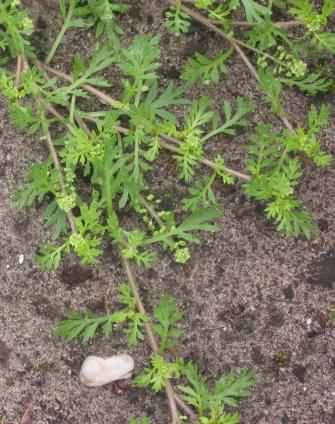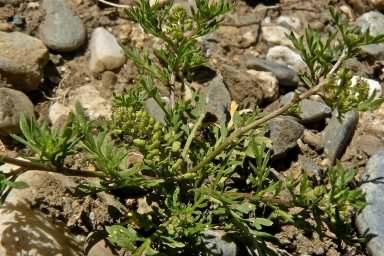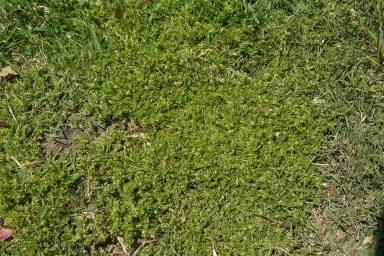
Photo ©2005 Rasbak
Click for a larger image
More photos
Photo ©2005 Rasbak
Click for a larger image
Lesser Swine–cress - Lepidium didymum
Family - Brassicaceae
Also known as - Coronopus didymus
An annual or biennial herb with decumbent and glabrous green stems attaining a height of up to 40cm (16in) long, radiating from a central position with a prostrate spreading habit. The very pungent leaves with a mustard like Cress smell when crushed are pinnate feathery and alternate up to 5cm (2in) long. Initially growing from a rosette which soon becomes a tangled mass of stems and leaves.
Inconspicuous white flowers in bloom between July and September, of four white petals and two to four very short stamens, one central stigmas, fruits to two rounded valves containing orange or red–brown seeds 1–5mm (0.4–0.2in) long. Didymum in Latin is "twin" or "in pairs" and refers to the seed capsules.
The plant is of an undefined origin but is often given as native to South America, however it is an introduced alien weed found naturalised across the world. In the UK it is found in mainly in southern England, south Wales and southern Ireland, in park and gardens, paths, waste ground, in lawns and beside roads.
FBCP do not advise or recommend that Lesser Swine–cress – Lepidium didymum is eaten or used as an herbal remedy. Lesser Swine–cress can be mistaken for Stag's–horn Plantain or Pineapple Weed,, but these are also both edible. Medicinally Lesser Swine Cress is reputed to have anti–inflammatory properties and when eaten has a hot, occasionally salty, cress or mustard flavour.
 Photo ©2013 Jean Pawek |
 Photo ©2013 Jean Pawek |
Site design ©1999– Brickfields Country Park - Privacy -